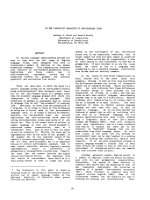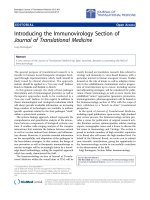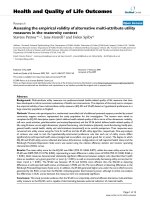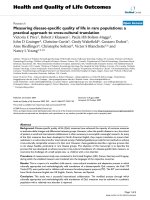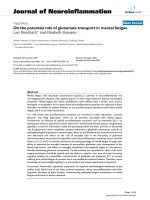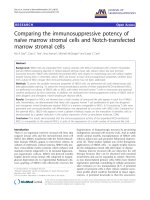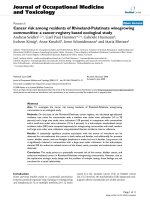Báo cáo hóa học: " Studying the local character of Raman features of single-walled carbon nanotubes along a bundle using TERS" potx
Bạn đang xem bản rút gọn của tài liệu. Xem và tải ngay bản đầy đủ của tài liệu tại đây (891.22 KB, 7 trang )
NANO EXPRESS Open Access
Studying the local character of Raman features of
single-walled carbon nanotubes along a bundle
using TERS
Niculina Peica
*
, Christian Thomsen, Janina Maultzsch
Abstract
Here, we show that the Raman intensity of the G-mode in tip-enhanced Raman spectroscopy (TERS) is strongly
dependent on the height of the bundle. Moreover, using TERS we are able to position different single-walled
carbon nanotubes along a bundle, by correlating the observed radial breathing mode (RBM) with the AFM
topography at the measuring point. The frequency of the G
-
mode behaves differently in TERS as compared to far-
field Raman. Using the RBM frequency, the diameters of the tubes were calculated and a very good agreement
with the G
-
-mode frequency was observed.
Introduction
Tip-enhanced Raman spectroscopy (TERS) became a
very useful technique in studying t he optical properties
of carbon nanotubes [1-6]. A previous study [7] on the
detection of s ingle-walled carbon nanotubes (SWCNT)
by using TERS concentrated on showing the G-mode
and the radial breathing mode (RBM) from a nan-
ometer-sized region that could not be visible in the
micro-Raman measurements. Another report [8] has
focused on studying the variations in the Raman spectra
of the G-mode and RBM by changing the polarization
conditions and has shown different behaviors for the
two distinct modes. Identification of the chiral indices of
SWCNT through the observed radial breathing mode
(RBM) in near-fiel d Raman and photoluminescence (PL)
of the nanotubes was reported as well [9]. Combining
near-field PL and near-field Raman imaging, Hartschuh
et al. [10] observed higher near-field enhancements
using PL and suggested that using these two techniques
for the study of individual SWCNTs it should be possi-
ble to correlate the structural defects with the emission
properties of the nanotubes. Recently, Roy and Williams
[11] developed a new spectrometer for high resolution
RamanimagingofSWCNTsandshowedTERSimages
of SWCNTs using radially polarized circular and
annular beams, respectively. In order to extract struc-
tural information from SWCNTs in bundles we com-
bine the AFM topography with the TERS and confocal
Raman measurements along an SWCNTs bundle. The
purpose of our study is to analyze the vibrational prop-
erties of SWCNTs along a bundle using TERS. From
the observed RBMs in the TERS spectra and the
extracted information from the AFM topography we
attribute each RBM to a nanostructure from the mea-
sured bundle. Moreover a correlation of the diameter-
dependent G
-
peaks to the assigned RBMs is discussed.
Experimental
The TERS measurements wer e per formed using a com-
mercially available combination of an AFM/STM XE-
100 from Park Systems and a LabRam HR-800 spectro-
meter from Horiba Jobin Yvon. For excitation , the 532.2
nm line from a doubled-frequency Nd:YAG laser was
used. The spectra were collected in backscattering geo-
metry with a resolution of 2 cm
-1
and recorded with a
Peltier-cooled CCD camera. The laser power on the
sample used in our measurements was 0.1 mW. The
TERS experiments were done in contact-mode AFM
with an Au-coated tip. The silicon nitride AFM tips
with a reflective Au-coating of 60 nm were purchased
from Veeco and were coated with an extra 20 nm Au
by thermal evaporation in a vacuum chamber kept at a
pressure of 10
-5
mbar. SWCNTs were produced by
* Correspondence:
Institut für Festkörperphysik, Technische Universität Berlin, Hardenbergstr. 36,
10623 Berlin, Germany
Peica et al. Nanoscale Research Letters 2011, 6:174
/>© 2011 Peica et al; licensee Springer. This is an Open Access article distributed under the terms of the Creative Commons Attribution
License (http://creativecommons. org/licenses/by/2.0), which permits unrestricted use, distribution, and reproduction in any medium,
provided the original work is properly cited.
high -pressure gas-phase decomposition of CO (HipCO),
deposited on a Si/SiO
2
substrate.
Results and discussion
We performed TERS and confocal Raman measure-
ments at seven different positions along a small
SWCNTs bundle in order to study the local character of
different Raman features of SWCNTs. The seven posi-
tions along the SWCNTs bundle are depicted in Figure
1 together with their corresponding AFM height pro-
files. Figure 1 shows the optically excited areas in the
far-field (green ellipse) as well as in the near-field (blue
circle). The tip-induced enhancement is coming from
the small excited area in the near-field (Figure 1, b lue
circle) whereas the total signal in TERS always includes
the confocal Raman signal, coming from the same area
as in the far-field (Figure 1, green ellipse) and thus
including more carbon nanostructures than the near-
field area. The incident laser is coming under an angle
of 60° with respect to the surface normal and its polari-
zation direction is depicted in Figure 1 by the y-axis of
the green ellipse.
The heights and the full widt hs at half maxima
(FWHM) of the peaks after a Lorentzian fit of the height
profiles are summarized in Table 1. The determined
FWHMs are between 21 and 94 nm and th e heights
rangefrom2to9nm.Theheightprofilesindicatethe
presence of an SWCNT bundle.
Radial breathing modes
IntheRBMregionoftheTERSspectrathreeorfour
different RBMs are observed at each of the marked
positions (Figure 1). In total seven different RBMs
are observed confirming the presence of an SWCNT
Figure 1 Left-hand side: Height profiles of the seven measured positions along an SWCNTs bundle. Rig ht-hand side: AFM topography
together with an approximation of the far-field spot area (green ellipse), diffraction-limited area (green circle), the near-field area (small blue
circle), and the y-polarization direction of the incident laser. (A), (B), and (C) denote the three different bundles observed in the AFM
topography. This notation is used in the RBM discussion part.
Peica et al. Nanoscale Research Letters 2011, 6:174
/>Page 2 of 7
bundle. In Table 2 we summarize all observed RBMs
together with a tentative chiral-in dex assignment. Tak-
ing into account the obser ved RBM frequencies and the
presence of bundled SWCNTs, the tubes’ diameters
were calculated [12] and based on previous theoretical
studies [13] a tentative assignment of the chiral indices
is also given (Table 2).
In order to explain the appearance of different RBMs
for each measured region, we will attempt to correlate
each RBM with the corresponding AFM topography. In
Figure 2, we see that RBM_7 is observed in the TERS
spectra at each of the considered sites. This enables us
to attribute its corresponding SWCNT to bundle (A)
(Figure 1). Its intensity varies longwise the measured
positions, becoming stronger at positi ons (3) and (4),in
accordance with the corresponding height profiles
(Table 1) of the nanostructure (A) (Figure 1).
At positions (1), (5), (2),and(6) the heights of the
nanostructure are lower than at position (4) (Table 1,
Figure 2b). Assuming a resulting increased distance
between tip and nanotube, weaker intensities of RBM_7
in the TERS spectra are expected (Figure 2). The smal-
lest intensity of RBM_7 is observed at position (7 ),but
it is still clearly visible probably because its correspond-
ing SWCNT is oriented almost parallel to the direction
of the laser polarization. Figure 2b shows the variation
of the RBM_7 intensity with the nanostructure height,
which can be reasonably fitted b y a linear function
(dashed line).
Taking into account the size of the far-field spot, we
conclude that bundle (B) contributes with its far-field
signal at each me asured point from (1) to (3).This
nanostructure ends probably before position (3) or
between positions (3 ) and (4). The responsible RBM for
this nanostructure should be RBM_1,asitispresent
only at positions (1) and (2) (see Table 2). Furthermore
we observe an RBM at 152 cm
-1
being very weak and
broad in the far-field Raman spectra taken at positions
Table 1 Heights and FWHM after a Lorentzian fit of the profiles at each measured position
Position Height 1 (nm) Height 2 (nm) FWHM 1 (nm) FWHM 2 (nm) Cumulated FWHM (nm)
1. 6.80* 61.37 61.37
2. 3.40* 49.28 49.28
3. 2.70 8.30* 34.58 76.56 111.14
4. 9.00* 55.61 55.61
5. 1.80 6.40* 21.71 84.82 106.53
6. 4.40* 10.00 47.43 93.98 141.41
7. 2.22* 53.69 53.69
The star-marked height profiles correspond to the tip position, and were used for plotting the Raman signal dependence as a function of the height.
Table 2 Summary of the RBM frequencies in the TERS spectra along the measured bundle together with their
calculated diameter and tentative chiral indices assignment
Position ω
RBM_1
(cm
-1
)
d
t
_
1
(nm)
ω
RBM_2
(cm
-1
)
d
t
_
2
(nm)
ω
RBM_3
(cm)
-1
d
t
_
3
(nm)
ω
RBM_4
(cm)
-1
d
t
_
4
(nm)
ω
RBM_5
(cm)
-1
d
t
_
5
(nm)
ω
RBM_6
(cm)
-1
d
t
_
6
(nm)
ω
RBM_7
(cm)
-1
d
t
_
7
(nm)
1. 150.1 wm
(1.63)
- 177.4 m
(1.35)
- - - 277.9 m
(0.83)
2. 150.1 wm
(1.63)
- 178.1 wm
(1.35)
- - - 277.1 ms
(0.83)
3. - 155.7 wm
(1.56)
- 181.5 wm
(1.32)
204.9 vw
(1.15)
- 277.5 vs
(0.83)
4. - - - 182.7 m
(1.31)
205.3 w
(1.15)
- 276.9 s
(0.83)
5. - - - 183.3 ms
(1.30)
205.7 w
(1.15)
- 277.2 m
(0.83)
6. - - - 182.8 m
(1.31)
- 244.2 wm
(0.95)
276.9 wm
(0.83)
7. - - - 181.8 w
(1.32)
- 244.1 w
(0.95)
279.7 w
(0.82)
(n,m)
E
ii
(eV)
(17,6)
S
2.030
(20,0)
S
2.035
(13,6)
S
2.014
(15,3)
M
2.764
(11,5)
M
2.003
(10,3)
S
2.581
(8,4)
S
2.880
(12,12)
M
2.539
(17,5)
M
2.436
(14,5)
M
2.763
(12,7)
S
2.251
(14,1)
S
2.178
(12,0)
M
1.934
(10,1)
M
2.100
w, weak; m, medium; s, strong; S, semi conducting; M, metallic.
Peica et al. Nanoscale Research Letters 2011, 6:174
/>Page 3 of 7
(1) and (2). This confirms the contribution of the confo-
cal Raman signal to the TERS signal. The absence of
RBM_1 in the TERS spectrum at position (3) and the
appearance of RBM_2 can be explained by another,
shorter tube lying on top of the tube corresponding to
RBM_1. This is in accordance with the AFM topogra-
phy of bundle (B). Furthermore, at positions (1) and (2)
another RBM could be observed, RBM_3,whichis
assigned to an SWCNT belonging to nanostructure (A)
because it is not visible in the far-field.
Beginning with position (3),anewRBM,denoted
RBM_4, emerges in the TERS spectra. This RBM_4
with high intensity from position (3) to (6) can be
attributed to the main nanostructu re (A) of the AFM
topography, which has a considerable height (Figure 1,
Table 2). As RBM_7 at positions (3) and (4) has consid-
erable larger intensity than RBM_4, the corresponding
tube might be closer to the tip as compared to the
SWCNT observed through RBM_4. At positions (5) and
(6), RBM_4 has slightly larger intensity than RBM_7,
which indicates that the corresponding tube might be
closer to the tip as compared to the SWCNT observed
through RBM_7. At the last position, according t o the
smaller height profile, the Ra man intensity of RBM_4 is
weak.
Moving on to RBM_5, which has a weaker intensity
(Figure 2, Table 2) and is observed in the TERS spectra
only at positions (3) to (5),wemightattributeittoa
new tube that belongs to nanostru cture (B) (Figure 1)
and is situated further away from the tip position. Its
weak intensi ty cannot be associated with the nanostruc-
ture heights at the three observed positions. Moreover
in the confocal Raman spectra a very weak and broad
feature at ~195 cm
-1
was observed. Thus, RBM_5 seems
to be a contribution from the far-field to the TERS
spectra. At positi ons (6) and (7), RBM_6 appears in the
TERS measurements. The presence of this RBM can evi-
dently be assigned to the new nanostructure (C) that
emerg es beginning with position (5). Its higher intensity
at position (6) is associated with its parallel orientation
to the direction of the laser polarization. This SWCNT
seems to be deeper situated, and by that, its intensity
does not exceed the highest intensity of other observed
RBMs. The weaker intensity of RBM_6 at position (7)
appears to be due to the smallest height (Figure 1, Table
1) of the nanostructure (C) at this position.
Figure 2 TERS intensity as a function of the position along the S WCNT bundle and bundle height, exemplified on RBM_7.(a)TERS
spectra in the RBM region at different positions, from (1) to (7) along the SWCNT bundle. The peaks marked with stars belong to the silicon
substrate. The colored numbers correspond to the RBM numbering given in Table 2. (b) RBM_7 TERS intensity as a function of the height of the
bundle at the seven measurements sites.
Peica et al. Nanoscale Research Letters 2011, 6:174
/>Page 4 of 7
In the confocal Raman spectra, as already mentioned,
very weak and broad or no RBM at all could be
observed. This might indicate that, on using the 2.33 eV
excitation line, we are slightly off-resonance with the
optical transitions of these carbon nanostructures.
The different RBMs observed in the TERS spectra at
the seven measured positions confirm the possibility to
locally characterize and to differentiate between indivi-
dual SWCNTs in a bundle. Therefore, due to its lateral
resolution, TERS may be successfully used in biology
and medicine making possible the characterization not
only at single cell level, but also at cell component level.
Moreover, the enhancement through the plasmon reso-
nances might open up new perspectives in the investiga-
tions of semiconduct ing materials (e.g., SiGe nanowi res)
and functionalized graphene.
G-mode
In Figure 3 we show the TERS and confocal Raman
spectra of the G-mode at the seven chosen positions.
Based on the assignment made for the RBM in the pre-
vious section, we will now discuss the dependence of
the G-mode on bundle height and nanotube chiral
index.
On enlarging the bundle size (i.e., higher features in
the AFM topography), an increase of the G-mode inten-
sity is to be expected. This can be partly due to the pre-
sumably smaller distance between the tip and the
nanotubes, for larger bundles. Undoubtedly, however, in
a larger bundle there are more carbon nanotubes contri-
buting to the recorded Raman signal. In contrast to the
RBM, the G
+
mode is only very slightly diameter-depen-
dent, and the resonance window is much wider. Indeed ,
when plotting the G
+
and G
-
intensities as a function of
the bundle height, we observe an increased intensity
with increasing height (see Figure 4).
Moreover, correlating the FWHM (Tab le 1) of the
nanostructures at the measured positions, one can
observethatinalargerbundlemorenanotubescontri-
bute to the TERS signal. For example, at positions (1)
and (5), where similar height profiles of bundles are
observed (Figure 1, Table 1), the TERS intensities of the
G
+
and G
-
modes are considerably higher for the smal-
ler bundle height [position (5), Figure 4]. Owing to an
FWHM of 84.82 nm at position (5), in comparison to
an FWHM of 61.37 nm at position (1), one can argue
that at position (5) the nanostructure is broader than at
position (1), and therefore, more nanotubes participate
to the TERS signal. These observations emphasize the
potential of the TERS technique to distinguish local
vibrational properties of nanometer-sized regions.
Further on we intend to correlate the o bserved G
-
peaks with the assigned RBMs. The G
+
and G
-
peak s in
semiconducting tubes correspond to the longitudinal
(axial) and transverse (circumferential) optical vibrations,
respectively, and vice versa in metallic nanotubes [14-16].
The G
-
peak in both metallic and semiconducting
Figure 3 TERS (red) and confocal Raman (blue) spectra of the
G-mode at seven positions along an SWCNT bundle. The gray
and light gray peaks represent the Lorentzian fits for the TERS and
confocal Raman spectra, respectively.
Figure 4 TERS and confocal Raman intensities of the G
+
-mode
(squares) and G
-
-mode (stars) as a function of the height of
the bundle at the seven measurement sites.
Peica et al. Nanoscale Research Letters 2011, 6:174
/>Page 5 of 7
nanotubes is strongly diameter-dependent. Using the
assignment of RBMs to the measured positions (1) to (7),
we plot the observed G
-
frequencies as a function of tube
diameters in Figure 5.
In the TERS and confocal Raman spectra, the position
of the G
+
-mode is preserved, at 1595 cm
-1
,whereasdif-
ferent G
-
-modes have been observed in TERS as com-
pared to the far-field spectra. Moreover, different G
-
-
modes are observed along the measured SWCNTs bun-
dle, two for the first four positions (1)-(4) and three for
positions (5)-(7). For positions (1) to (4),thefirstG
-
-
peak is present at 1572 cm
-1
in both TERS and confocal
Raman measurements, whereas the second G
-
-mode
exhibits different positions (Table 3).
For positions (5) to (7), a new G
-
peak with a constant
frequency of 1581 cm
-1
inTERSandof1575cm
-1
in
confocal Raman was observed. The G
-
-mode observed
previously at 1572 cm
-1
is now present at 1569 cm
-1
,
and the third G
-
-peak has different frequencies for each
position in TERS and confocal Raman, respectively (see
Table 3). The appearance of various G
-
modes at differ-
ent positions along the measured bundle, and in TERS
in comparison to the confocal Raman measurements,
prove the effectiveness to identify the local character of
this Raman feature with a spatial resolution of 100 nm
by using TERS. This spatial resolution is based on the
30 nm radius of the Au-coated tip we have used and on
the distances between the measured positions along
an SWCNTs bundle. Thus, TERS enables the local
detection and identification of optical properties of the
measured SWCNTs bundle. Moreover, the detection of
the different G
-
-mode in T ERS can be associated with
the local detection of different SWCNTs in a bundle. In
this sense, based on the calculated tube diameters
(Table 2) by using the observed RBM frequencies, we
have correlated the obser ved G
-
-modes along the mea-
sured bundles with previous calculations [16]. Taking
into account the calculated diameter of the tube we
found good agreement w ith the theoretically predicted
values [16] of the corresponding G
-
-modes. These were
correlated with the G
-
-frequencies from our TERS and
confocal Raman measurements (Figure 5).
Considering the increasing of the frequency with the
increase in the diameter, one can assume that the G
-
-
frequency for tube 1 (d
t_1
=1.63nm,Table2)isvery
close to the G
+
-mode frequency, and for this reason is
not observed as a separate peak in the Raman spectra.
However , the first G
-
-peak appears to be broader in the
TERS spectra at positions (1) to (3). Therefore, it is pos-
sible that due to this broad G
-
-modewedonotresolve
the G
-
-mode corresponding to the tube 1. As for the
second proposed chiral-index assignment, no experi-
mental G
-
-frequency fits to the calculated value. As the
theoretical energy E
ii
(Table 2) is much higher than that
of the excitation energy we have used, the assignment to
a metallic tube is not supported.
For tube 2 (d
t_2
= 1.56 nm), taking into account the
observed RBM, two different chiral indices could be
considered for the assignment. However, considering the
observed G
-
-frequency for both TERS a nd confocal
Raman measurements (Figure 5) and that the observed
RBM in the TERS spectra appears as a contribution
from the confocal Raman signal, one can exclude the
attribution to a metallic tube. Therefore the attribution
to (20,0) chiral- index tube ( Table 2, Figure 5) is in goo d
agreement with both RBM and G
-
-mode frequencies
assignment.
In the case of tube 3 (d
t_3
=1.35nm),whoseRBMwas
observed only in the TERS spectra, two chiral indices
were proposed. However, one of them corresponds to a
Figure 5 Calculated (from ref. [16]) and experimental TERS and
confocal Raman G
-
-mode frequencies as a function of the
calculated tube diameter. The dashed lines are drawn to guide
the eye and refer to the theoretical data. SEM, semiconducting;
MET, metallic.
Table 3 Summary of the G- frequencies in the TERS and
confocal Raman spectra along the measured bundle
Position Frequency (cm
-1
) in TERS Frequency (cm
-1
) in confocal
G
-
1
G
-
2
G
-
3
G
-
1
G
-
2
G
-
3
1. 1556 1572 - 1554 1572 -
2. 1558 1572 - 1544 1572 -
3. 1543 1572 - 1557 1572 -
4. 1534 1572 - 1557 1572 -
5. 1539 1569 1581 1544 1569 1575
6. 1547 1569 1581 1541 1569 1575
7. 1547 1569 1581 1548 1569 1575
Peica et al. Nanoscale Research Letters 2011, 6:174
/>Page 6 of 7
higher energy shift in compar ison to the used excitation
energy (Table 2). Considering the observed G
-
-frequency
(Figure 5), the assignment to a semiconducting nanotube
(13,6) is very likely.
The fourth observed RBM in the TERS spectra
at positions (3) to (7) corresponds to tube 4 and its
diameter, d
t_4
, varies between 1.30 and 1.32 nm.
Furtheron, accounting for the observed G
-
-frequencies
in the TERS and confocal Raman spectra, we can prove
that two different tubes coexist in bund le (A) .Dueto
the excitation energy of the incoming laser at the tip
apex, localized surface plasmons are excited in the
apex or in the gap between the tip and the sample and
therefore small shifts of the plasmon resonance can
occur. These induce small shifts in the RBM frequen-
cies and therefore tubes with slightly different dia-
meters are observed.
For tube 5 (d
t_5
= 1.15 nm), whose RBM was observed
in TERS as a contribution from the far-field, also two
different chiral-indices assignment were proposed.
Accounting for the observed G
-
-frequencies, one can
conclude that the likely assignment is to a metallic tube
(11,5) (Table 2, Figure 5).
Based on the good agreement with the experimental G
-
-
frequencies in the TERS and confocal Raman measure-
ments, we have assigned tubes 6 (d
t_6
=0.95nm)and7
(d
t_7
= 0.83 nm) to semiconducting tubes (Table 2).
Our experimental work using TERS enabled us to
observe more G
-
-frequency modes than would have
been possible by using conventional Raman spectro-
scopy. This allows us to precisely correlate the observed
frequencies to the tubes’ diameter, providing a more
accurate assignment of the vibratio nal modes. This
underlines once more the potential and the perspectives
opened up by using the TERS technique in spectrosco-
pically investigating nanoscaled materials.
Conclusions
Using TERS we have probed the variation of the Raman
signal of SWCNTs at seven different positions along a
bundle. The TERS intensity of G-mode in carbon nano-
tubes is strongly dependent on the height of the bundle.
Moreover, the frequency of the G
-
-mode changes from
one position to the other in TERS demonstrating the
strong dependence of the Raman signal on the local
position along the bundle. Correlating the observed
RBMs with the AFM topography we were able to iden-
tify several tubes within the observed bundles. Using
TERS it is possible to differentiate between SWCNTs in
bundles by using the observed RBMs. Furthermore,
recording confocal Raman and TERS measurements at
seven positions along a bundle we could give an accu-
rate chiral-indices assignment, considering both, RBM
and G
-
-mode frequencies.
Abbreviations
FWHM: full widths at half maxima; HipCO: high-pressure gas-phase
decomposition of CO; PL: photoluminescence; RBM: radial breathing mode;
SWCNT: single-walled carbon nanotubes; TERS: tip-enhanced Raman
spectroscopy.
Acknowledgements
We gratefully acknowledge financial support from the DFG Cluster of
Excellence “Unifying Concepts in Catalysis.”
Authors’ contributions
NP carried out the experiment and analyzed the data; NP and JM conceived
the experiment; NP, JM, and CT discussed the results and contributed to
writing the manuscript.
Competing interests
The authors declare that they have no competing interests.
Received: 6 September 2010 Accepted: 25 February 2011
Published: 25 February 2011
References
1. Yano T, Inouye Y, Kawata S: Nanoscale Uniaxial Pressure Effect of a
Carbon Nanotube Bundle on Tip-Enhanced Near-Field Raman Spectra.
Nano Lett 2006, 6:1269.
2. Anderson N, Hartschuh A, Novotny L: Chirality Changes in Carbon Nanotubes
Studied with Near-Field Raman Spectroscopy. Nano Lett 2007, 7:577.
3. Hartschuh A, Qian H, Georgi C, Böhmler M, Novotny L: Tip-enhanced near-
field optical microscopy of carbon nanotubes. Anal Bioanal Chem 2009,
394:1787.
4. Yano T, Verma P, Saito Y, Ichimura T, Kawata S: Pressure-assisted tip-
enhanced Raman imaging at a resolution of a few nanometers. Nat
Photon 2009, 3:473.
5. Cançado LG, Jorio A, Ismach A, Joselevich E, Hartschuh A, Novotny L:
Mechanism of Near-Field Raman Enhancement in One-Dimensional
Systems. Phys Rev Lett 2009, 103:186101.
6. Peica N, Thomsen C, Maultzsch J: Tip-enhanced Raman scattering along a
single wall carbon nanotubes bundle. Phys Status Solidi B 2010, 247:2818.
7. Hayazawa N, Yano T, Watanabe H, Inouye Y, Kawata S: Detection of an
individual single-wall carbon nanotube by tip-enhanced near-field
Raman spectroscopy. Chem Phys Lett 2003, 376:174.
8. Saito Y, Hayazawa N, Kataura H, Murakami T, Tsukagoshi K, Inouye Y, Kawata S:
Polarization measurements in tip-enhanced Raman spectroscopy applied
to single-walled carbon nanotubes. Chem Phys Lett 2005, 410:136.
9. Hartschuh A, Qian H, Meixner AJ, Anderson AJ, Novotny L: Nanoscale optical
imaging of single-walled carbon nanotubes. JLuminesc2006, 119-120:204.
10. Hartschuh A, Qian H, Meixner AJ, Anderson N, Novotny L: Nanoscale
Optical Imaging of Excitons in Single-Walled Carbon Nanotubes. Nano
Lett 2005, 5:2310.
11. Roy D, Williams C: High resolution Raman imaging of single wall carbon
nanotubes using electrochemically etched gold tips and a radially
polarized annular beam. J Vac Sci Technol A 2010, 28:472.
12. Thomsen C, Telg H, Maultzsch J, Reich S: Chirality assignments in carbon
nanotubes based on resonant Raman scattering. Phys Status Solidi B 2005,
242:1802.
13. Popov VN, Henrard L, Lambin P: Electron-phonon and electron-photon
interactions and resonant Raman scattering from the radial-breathing
mode of single-walled carbon naotubes. Phys Rev B 2005, 72:035436.
14. Maultzsch J, Reich S, Schlecht U, Thomsen C: High-Energy Phonon
Branches of an Individual Metallic Carbon Nanotube. Phys Rev Lett 2003,
91:087402.
15. Lazzeri M, Piscanec S, Mauri F, Ferrari AC, Robertson J: Phonon linewidths
and electron-phonon coupling in graphite and nanotubes.
Phys Rev B
2006, 73:155426.
16. Dubay O, Kresse G, Kuzmany H: Phonon Softening in Metallic Nanotubes
by a Peierls-like Mechanism. Phys Rev Lett 2002, 88:235506.
doi:10.1186/1556-276X-6-174
Cite this article as: Peica et al.: Studying the local character of Raman
features of single-walled carbon nanotubes along a bundle using TERS.
Nanoscale Research Letters 2011 6:174.
Peica et al. Nanoscale Research Letters 2011, 6:174
/>Page 7 of 7
